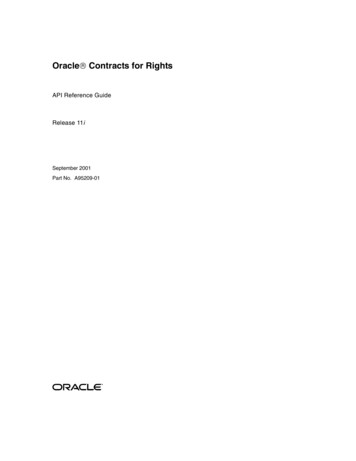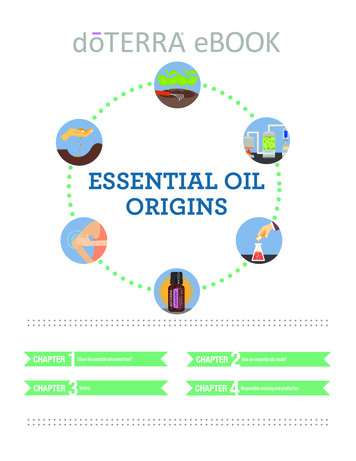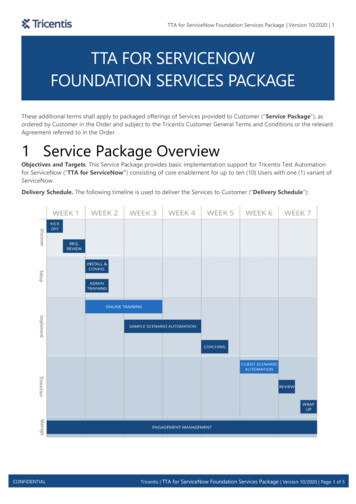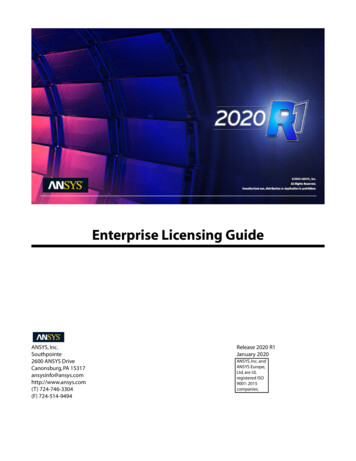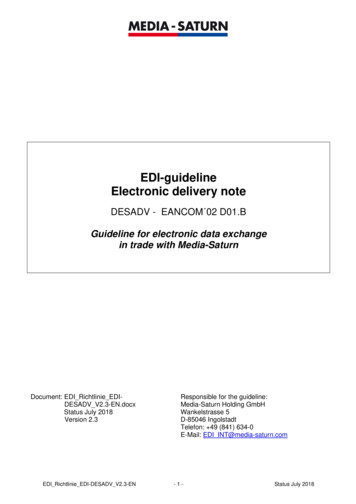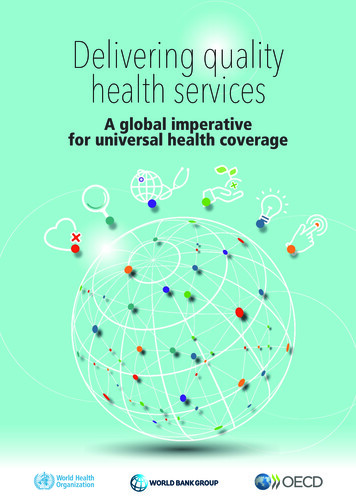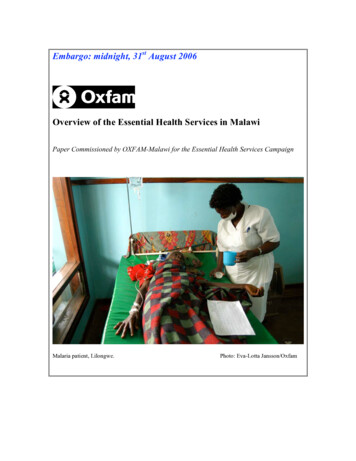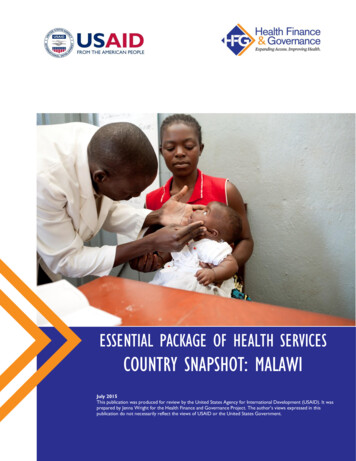
Transcription
ESSENTIAL PACKAGE OF HEALTH SERVICESCOUNTRY SNAPSHOT: MALAWIJuly 2015This publication was produced for review by the United States Agency for International Development (USAID). It wasprepared by Jenna Wright for the Health Finance and Governance Project. The author’s views expressed in thispublication do not necessarily reflect the views of USAID or the United States Government.
The Health Finance and Governance ProjectUSAID’s Health Finance and Governance (HFG) project helps to improve health in developing countries byexpanding people’s access to health care. Led by Abt Associates, the project team works with partner countries toincrease their domestic resources for health, manage those precious resources more effectively, and make wisepurchasing decisions. As a result, this five-year, 209 million global project increases the use of both primary andpriority health services, including HIV/AIDS, tuberculosis, malaria, and reproductive health services. Designed tofundamentally strengthen health systems, HFG supports countries as they navigate the economic transitionsneeded to achieve universal health care.July 2015Cooperative Agreement No: AID-OAA-A-12-00080Submitted to: Scott Stewart, AORJodi Charles, Senior Health Systems AdvisorOffice of Health SystemsBureau for Global HealthRecommended Citation: Wright, J., Health Finance & Governance Project. July 2015. Essential Package ofHealth Services Country Snapshot: Malawi. Bethesda, MD: Health Finance & Governance Project, Abt Associates Inc.Photo Credit: Malawi, March 2012. Credit: Jessica ScrantonAbt Associates Inc. 4550 Montgomery Avenue, Suite 800 North Bethesda, Maryland 20814T: 301.347.5000 F: 301.652.3916 www.abtassociates.comAvenir Health Broad Branch Associates Development Alternatives Inc. (DAI) Johns Hopkins Bloomberg School of Public Health (JHSPH) Results for Development Institute (R4D) RTI International Training Resources Group, Inc. (TRG)
CONTENTSAcronyms. iAbout the Essential Packages of Health Services Country Snapshot Series . 1The Essential Package of Health Services (EPHS) in Malawi . 2Priority Reproductive, Maternal, Newborn and Child Health Interventions. 2Use of Selected Priority Services . 3How the Health System Delivers the EPHS . 3Delivering the EPHS to Different Population Groups . 4Providing Financial Protection for the EPHS . 4Sources. 5Annex A. Malawi's EPHS . 7Annex B. Comparison between the EPHS and the PriorityRMNCH Services . 23Annex C: Malawi Health Equity Profile . 27ACRONYMSBLMBanja La MtsogoloCHAMChristian Health Association of MalawiEPHSEssential Package of Health ServicesRMNCHReproductive, maternal, newborn and child health
ABOUT THE ESSENTIAL PACKAGES OFHEALTH SERVICES COUNTRY SNAPSHOT SERIESAn Essential Package of Health Services (EPHS) can be defined as the package of services that thegovernment is providing or is aspiring to provide to its citizens in an equitable manner. Essentialpackages are often expected to achieve multiple goals: improved efficiency, equity, politicalempowerment, accountability, and altogether more effective care. There is no universal essentialpackage of health services that applies to every country in the world, nor is it expected that all healthexpenditures in any given country be directed toward provision of that package. Countries vary withrespect to disease burden, level of poverty and inequality, moral code, social preferences, operationalchallenges, financial challenges, and more, and a country’s EPHS should reflect those factors.This country snapshot is one in a series of 24 snapshots produced by the Health Finance & GovernanceProject as part of an activity looking at the Governance Dimensions of Essential Packages of HealthServices in the Ending Preventable Child and Maternal Death priority countries. The snapshot exploresseveral important dimensions of the EPHS in the country, such as how government policies contributeto the service coverage, population coverage, and financial coverage of the package. The informationpresented in this country snapshot feeds into a larger cross-country comparative analysis undertaken bythe Health Finance & Governance Project to identify broader themes related to how countries use anEPHS and related policies and programs to improve health service delivery and health outcomes.Each country snapshot includes annexes that contain further information about the EPHS. Whenavailable, this includes the country’s most recently published package; a comparison of the country’spackage to the list of priority reproductive, maternal, newborn and child health interventions developedby the Partnership for Maternal, Newborn and Child Health in 2011 (PMNCH 2011), and a profile ofhealth equity in the country.1
THE ESSENTIAL PACKAGE OFHEALTH SERVICES (EPHS) IN MALAWIMalawi first developed its EPHS, referred to as the Essential Health Package, in 2004 under the Programof Work (2004–2010). The successor document to the Program of Work is the Malawi Health SectorStrategic Plan (2011–2016), which emphasizes improving coverage and quality of EPHS deliverythroughout the country. This document makes the EPHS the centerpiece of the health sector strategy,and builds most of the strategies and outcomes around it. For the full list of services, see Annex A.Priority Reproductive, Maternal, Newborn andChild Health InterventionsTo see a comparison of Malawi’s EPHS and the priority reproductive, maternal, newborn and childhealth (RMNCH) interventions (PMNCH 2011), refer to Annex B.Status of Servicein EPHSStatus Definition# of ServicesIncludedThe literature on the essential package specifically mentioned that thisservice was included.39Explicitly ExcludedThe literature on the essential package specifically mentioned that thisservice was not included.0Implicitly ExcludedThis service was not specifically mentioned, and is not clinically relevant toone of the high-level groups of services included in the essential package.The literature on the essential package did not specifically mention thisservice, but this service is clinically relevant to one of the high-level groupsof services included in the essential package.Unspecified516The following five priority RMNCH interventions are implicitly excluded from Malawi's EPHS: Safe abortion Social support during childbirth Routine immunization plus H. influenzae, meningococcal, pneumococcal, and rotavirus vaccines Home visits for women and children across the continuum of care Women's groups2
Use of Selected Priority ServicesThe table below presents the country’s data on common indicators. Empty cells signify that these dataare not available.IndicatorYearValueUrban ValueRural ValuePregnant women sleeping under insecticide-treated nets (%)201043.634.0Births attended by skilled health personnel (in the five yearspreceding the survey) (%)20108469.2BCG immunization coverage among one-year-olds (%)201396Diphtheria tetanus toxoid and pertussis (DTP3) immunizationcoverage among one-year-olds (%)201389Median availability of selected generic medicines (%)—privateMedian availability of selected generic medicines (%)—publicSource: Global Health Observatory, World Health Organization.How the Health System Delivers the EPHSRMNCH services from the EPHS are delivered through: government-sponsored community health workers public sector primary care facilities public sector referral facilitiesThe EPHS in Malawi is delivered through community health workers, public sector facilities, and publicprivate partnerships.Community health workers include health surveillance assistants (who provide HIV counseling andtesting, immunizations, and sometimes case management of childhood illnesses); community-baseddistributing agents; and village health committees. The public sector consists of primary, secondary, andtertiary levels. The primary level includes outreach/mobile clinics, community initiatives, health posts,maternity facilities, dispensaries, health centers, and rural hospitals. The secondary level includes districthospitals, which provide referral and inpatient services from the primary-level facilities, and also providesignificant primary-level care to the local population. The tertiary level includes the four centralhospitals, which are supposed to provide tertiary and specialty care for their region. In reality, thetertiary hospitals also provide primary care, and as a result are overburdened (Malawi Health SectorStrategic Plan 2011–2016).Public-private partnerships also serve as a means of delivering the EPHS in Malawi. Through thedevolved health management system, district health officers are encouraged by the central governmentto sign service-level agreements with nongovernmental health facilities to improve the local availability ofthe EPHS. District health officers have signed agreements with some private sector facilities managed bythe Christian Health Association of Malawi (CHAM) or Banja La Mtsogolo (BLM) (which normally chargeuser fees to cover operational costs) to provide some or all of the services in the EPHS for free tovulnerable populations. As of the drafting of the Malawi Health Sector Strategic Plan 2011–2016, theMinistry of Health and district health officers had signed such agreements with 72 of the 172 facilities,mainly for the delivery of maternal and newborn health services.3
Delivering the EPHS to Different Population GroupsThe government’s strategy for implementing the EPHS includes specific activities to improve equity ofaccess for specific populations; these include: women, the indigent, and rural populations.See Annex C for the World Health Organization's full health equity profile of Malawi based on datafrom a 2010 Demographic and Health Survey.Key findings from the health equity profile include: Health service coverage in Malawi appears to be relatively equitable across wealth quintiles,education level, and place of residence. Approximately 60 percent of people across wealth quintiles report that their needs for familyplanning are satisfied, with only a slight increase as wealth increases. Coverage of at least one antenatal care visit is above 90 percent, regardless of education level of themother. BCG immunization coverage is 97 percent among people with rural place of residence, compared to98 percent among people with urban place of residence.The Malawi Health Sector Strategic Plan 2011-2016 defines the following population groups as vulnerable:poor people, women, children, orphans, people with disabilities and the elderly, persons living in hard tostaff/serve areas, and displaced persons (including refugees and persons displaced due to naturaldisasters). The document states that the Ministry of Health and stakeholders will ensure that the specialhealth needs of these vulnerable groups are addressed during implementation of the Plan. Some specificactivities for these groups include conducting outreach/mobile clinics and signing more service-levelagreements with CHAM to ensure access to free services from the EPHS.Providing Financial Protection for the EPHS Some services included in the EPHS are legally exempt from user fees on a national scale.Much of the population is not covered by health insurance in Malawi. The government of Malawi doesnot currently sponsor any social health insurance schemes. Lately, microfinance institutions haveexpressed interest in becoming active agents for the development of mutual health insurance, with theaim of increasing social health protection for informal sector workers and rural populations (Abiiro et al.2014). However, so far, this does not appear to have happened.The government currently requires public sector facilities to provide the EPHS free of charge (except inpaying wings of district and central hospitals), except that citizens who self-refer to higher-level facilitieswithout following referral rules are assessed a by-pass fee. However, when CHAM or another privatefacility serves as the sole health facility in an area, services from the EPHS are not necessarily providedfree. The central government encourages district health officers to sign service-level agreements withthese facilities and provide some form of payment to the facility in exchange for the facility waiving userfees for some or all of the services. At this time, it is not a national requirement for the nonprofit facilityto sign a service-level agreement, or to waive user fees for some or all services in the EPHS.4
SOURCESAbiiro, G., G. Leppert, G. Mbera, P. Robyn, and M. Allegri. 2014. Developing Attributes and AttributeLevels for a Discrete Choice Experiment on Micro Health Insurance in Rural Malawi. BMC HealthServices Research 2014, 14:235 doi:10.1186/1472-6963-14-235.Malawi: EquityProfile - Reproductive, Maternal, Newborn and Child Health Services. World HealthOrganization. Accessed March 2015 at http://www.who.int/gho/health equity/countries/en/Ministry of Health, Government of Malawi. 2001. National Reproductive Health Service Delivery Guidelines.Ministry of Health, Government of Malawi. 2007. National Nutrition Guidelines for Malawi.Ministry of Health, Government of Malawi. 2009. Malawi Standard Treatment Guidelines, Fourth Edition.Ministry of Health, Government of Malawi. Malawi Health Sector Strategic Plan 2011–2016. Lilongwe.Partnership for Maternal, Newborn & Child Health. 2011. A Global Review of the Key InterventionsRelated to Reproductive, Maternal, Newborn and Child Health (RMNCH). Geneva, Switzerland:PMNCH.5
ANNEX A. MALAWI'S EPHS7
8
20112016Government of MalawiMinistry of HealthMalawiHealth Sector Strategic Plan2011 - 2016Moving towards equity and qualityMinistry of HealthPO Box 3077LILONGWE 3Malawii
nt and EmergencyAssociation of Accounting TechniciansAssociation of Chartered Certified AccountantsAccelerated Child Survival and DevelopmentArtemisinin-based Combination TherapyArea Development CommitteeAccountant General’s DepartmentAnnual Implementation PlanAnnual Joint ReviewAntenatal ClinicAcute Respiratory InfectionsAntiretroviral TherapyAfrican UnionBehaviour Change CommunicationBasic Emergency Obstetric and Neonatal CareBanja La MtsogoloBurden of DiseaseBlood pressureCommunity Based Home Based CareCommunity Based OrganizationCommunity Based RehabilitationCongestive Cardiac FailureCenter for Disease Control and PreventionCase Detection RateComprehensive Emergency Obstetric and Neonatal CareCore GroupCentral HospitalChristian Health Association in of MalawiCommunity Health Sciences UnitCentral Monitoring and Evaluation DepartmentChild Mortality RateCentral Medical StoresCommission on Health Research for DevelopmentCollege of MedicineContraceptive Prevalence RateCotrimoxazole Preventive TherapyCerebrospinal FluidCivil Society OrganisationDisability Adjusted Life YearDistrict CommissionersDistrict Executive CommitteeDepartment for International DevelopmentDistrict Health Management TeamDistrict Health OfficerDemographic and Health SurveyDistrict Implementation PlanDepartment of Disaster Preparedness Management AffairsDirectly Observed Treatment, Short Course (for Tuberculosis)Department of Public Sector ManagementDiphtheria, Pertussis and TetanusDrug Revolving FundEnvironmental Healthvii
DRCIECIFMISIHDIHP IMCIIMRIPSASIPTIRSITITNEssential Health PackageEmergency Human Resource PlanEssential Medicines ListEmergency Obstetric CareEmergency Obstetric and Neonatal CareEssential Medicines and SuppliesFocussed Ante Natal CareFaith Based OrganizationFocus Group DiscussionFlemish International Cooperation AgencyFinancial ManagementFinancial Management Improvement PlanFinancial Management ReportFamily PlanningFood, Safety and HygieneGender-based violenceGood Clinical Laboratory PracticeGross Domestic ProductGlobal Fund for the Fight against AIDS, Tuberculosis and MalariaGovernment of MalawiGroup Village HeadmanHealth Centre Advisory CommitteeHealth Centre Management CommitteeHealth Care WorkerHealth Development PartnersHealth Education UnitHealth Information SystemHealth Management Information SystemHuman PapillomavirusHuman ResourcesHealth Research Capacity Strengthening InitiativeHuman Resources for HealthHuman Resources Management Information SystemHealth Surveillance AssistantHealth Services CommissionHealth Systems StrengtheningHealth Sector Strategic PlanHealth Sector Working GroupHIV Testing and CounsellingInternal AuditInternational Classification of Functioning, Disability and HealthInformation and Communication TechnologyInternational Development Research CentreInformation Education and CommunicationIntegrated Financial Management Information SystemIschaemic Heart DiseaseInternational Health Partnerships and other InitiativesIntegrated Management of Childhood IllnessInfant Mortality RateInternational Public Sector Accounting StandardsIntermittent Preventive TreatmentIndoor Residual SprayingInformation TechnologyInsecticide Treated Netsviii
ntra Uterine Contraceptive DeviceJoint Assessment of National Strategic PlansJoint Annual ReviewKamuzu College of NursingLymphatic filariasisLonger Lasting Insecticide Treated NetLogistics Management Information SystemLower Respiratory InfectionsMonitoring and EvaluationMost At Risk PopulationsMalawi Socio-Economic DatabaseMalawi Blood Transfusion ServiceMaternal and Child HealthMillennium Development Goal(s)Multi Drug ResistantMalawi Growth and Development StrategyMultiple Indicators Cluster SurveyMaternal Mortality Ratio/RateMinistry of Education, Science and TechnologyMinistry of FinanceMinistry of HealthMinistry of Local Government and Rural DevelopmentMemorandum of UnderstandingMember of ParliamentMother To ChildMedium Term Expenditure FrameworkMalawi Traditional Healers Umbrella OrganizationMedium Mid-Term ReviewManual Vacuum AspirationMid-Year ReviewMzuzu UniversityNational Audit OfficeNon-Communicable DiseaseNational Commission for Science and TechnologyNational Drug PolicyNon-Governmental OrganizationNational Health AccountsNational Health Sciences Research CommitteeNational Local Government Finance CommitteeNeonatal Mortality RateNational Public Health InstituteNational Statistical OfficeNeglected Tropical DiseasesOffice of the Director of Public ProcurementOpportunistic InfectionOffice of the President & CabinetOral Rehydration SolutionOral Rehydration TherapyPost Abortion CarePhysical Assets ManagementPerformance-Based ManagementPrimary CarePublic Expenditure and Financial AccountabilityPublic Financial Managementix
MVHVHCVIAVSOWASHWHOWHSZHSOParticipatory Sanitation And Hygiene TransformationPrimary Health CarePublic Health LaboratoryPerformance Indicator for MissionPeople Living with HIVPrevention of Mother to Child Transmission of HIVPost Natal CareProgram of WorkPublic Private PartnershipPersons with DisabilitiesQuality AssuranceQuality ManagementReproductive HealthRadiology Standard Operational GuidelinesRoad Traffic AccidentsRational Use of MedicinesSocial Behaviour Change CommunicationStandard Based Management and RecognitionStaff Development InstituteService Delivery PointSocial Health InsuranceService Level AgreementSenior Management CommitteeStandard Operating ProceduresSulfadoxine-pyrimethamineSexual and Reproductive HealthSoil Transmitted HelminthsSexually Transmitted InfectionSector Wide ApproachTechnical AssistanceTraditional AuthorityTraditional Birth AttendantTotal Fertility RateTerms of ReferenceTrainer of TrainersTetanus ToxoidTechnical Working GroupUnder Five Mortality RateUnited Nations Population FundUnited Nations Children’s FundUnited States Agency for International DevelopmentVillage Development CommitteeValue For MoneyVillage HeadmanVillage Health CommitteeVisual Inspection with Acetic AcidVoluntary Services OverseasWater, Sanitation and HygieneWorld Health OrganizationWorld Health SurveyZonal Health Support Officex
20112016 Burden of diseaseCost effectivenessAccess to the poorMDG conditionProven successful interventionDiscrete earmarked funding through bilateral agreementsThe following table gives an overview of the key cost effective interventions for EHPconditions:Table 3 Cost effective interventions in the EHPEHP sAdverse maternaland neonataloutcomes3940InterventionsMulti level BCC across all sectorsHealth promotion39Screening (HIV testing and counselling through all entry points)Provision of home based careProcurement and provision of male and female condomsProvision of ARTProvision of PMTCT servicesCPTBlood and needle safetySTIs - Screening and treatment and promotionTreatment of opportunistic infectionsPeer and education Programs for high risk groupsCondom promotion and distributionHealth promotion on recognition of danger signs for ARIsEarly treatment of ARIs using standard protocolsTreatment of pneumoniaHealth promotionEarly treatment of malaria at household, community and health centrelevelPromotion and use of LLITNsPromotion and use of IRSVector control - Larvaciding and control of breeding sitesIPT pregnancyHealth promotionEarly care seeking – use of ORTProvision of zincConstruction of low cost excreta disposalProvision of home solutionsPromotion of exclusive breastfeedingSurveillance of water and food quality 40Health promotionPromotion and provision of family planning methodsPromotion of institutional deliveriesProvision of services for complications of delivery (BEmONC and EmoNC)Screening for cervical cancer using VIARepair of obstetric fistulaHealth promotion includes IEC, behaviour change communication, social mobilisation, screening, etc.Other stakeholders such as Ministry of Irrigation and Water Development are involved.42
20112016EHP conditionNCDs and tablediseasesMental illnessincluding epilepsyNTDsEye, ear and skininfectionsInterventionsHealth promotion on awareness about health risks such as smoking anddrinking of alcohol, safe driving and gender based violenceScreening for risk factors and conditions (cardiovascular, diabetes)Promote physical activityPromote healthy dietsCommunity and facility based rehabilitation, first aidCommunity DOTSHealth promotionTreatment of TB including MDRPromotion of exclusive breastfeedingGrowth monitoringDe-wormingMicronutrient supplementationTreatment of severe acute malnutritionHealth promotionEarly screening (cervical and breast cancer, Kaposi’s sarcoma)Treatment with cryotherapy and surgery (scaling up)Health sHealth promotion interventions to create awareness about mental healthMental health promotion in schools and workplacesTreatment of epilepsyTreatment of acute neuropsychiatric conditions – inpatientRehabilitationCase finding and treatment of TrypanosomiasisLF mass drug administrationMass drug administration for onchocerciasisSTH mass drug administration in school childrenMass drug administrationHealth promotion on prevention of eye, ear and skin infectionsTreatment of conjunctivitis, acute otitis media, scabies and trachomaAs has been the case in the PoW, the EHP will continue to be provided free of charge overthe period of the HSSP. For each disease and condition, the level of burden of disease andthe estimate of the cost effectiveness of the relevant intervention are found in the BOD 2011and in the publication Disease Control Priorities in Developing Countries41. The findings aresummarised below in Figure 14, which shows: the conditions with disease burdens above and below 10,000 DALYs per year, interventions above and below 150/DALY (the threshold below which interventions areparticularly good value for money in developing countries) and 1050/DALY (the threshold above which interventions are considered too expensive forthe economy of the country (amounting to three times the GNP).41Second edition, World Bank, 200643
20112016Annex 9An EHP for Malawi defined by level of health care deliveryPrimary health careStrategyCommunityHealth centreSecondary health careCommunityhospitalsDistrict hospitalsTertiary careZomba alMoH HQhospitals (KCH,QECH, Zomba,Mzuzu)Public health interventions: Disease prevention and health promotion (individuals / communities / settings)ImplementIntegrated vectorcontrol measures inall settings:community, schools,orphanages,workplaces, healthfacilitiesPromote healthylifestyle /behaviourchange throughcommunitymobilization, IEC/advocacy andhealthy settingsprogrammes.Promote earlyrecognition ofdanger signs, mentalhealth.Provision of IRSservices in highrisk areasPromote andcarry outdrainage andlarviciding ofvector (mosquito)breeding sites inall settingsProvision ofLLITNs (HH level)Community/socialmobilisation.IEC / advocacy onEarly recognitionof danger signs ofEHP conditions,mental vision of IRS in all health facilities and all levelsDrainage and larviciding surrounding areas at all health facilitiesProvision of LLITNs in all health facility wardsCommunity/socialmobilisation,IEC / advocacy onEarly recognition ofdanger signs of EHPconditions, mentalhealth promotion,lifestyle, nutrition,disability.IEC / advocacy on Early recognition of danger signs of EHP conditions,mental health promotion, lifestyle, nutrition, patient support groups126Advocate for healthyenvironmental policiesConduct Environmentalimpact assessmentDevelop policies ,guidelines and standardsAdvocate for companiesto fulfill their corporateresponsibilities towardshealth (environmentalcontrol , larviciding, etc)Develop communicationstrategies, and supportdistricts to developcommunicationstrategies based onpriority areas/EHPconditions
20112016StrategyPromote safewater, sanitationand hygienePromote healthysettingsprogrammes(workplace,village, urban/healthy cities,etc)Promote familyplanningPrimary health careCommunityHealth centreAddress priority issuesbased on diseaseburden:Environmental andpersonal hygiene, safewater and sanitation,nutrition, food serviceoutlets inspections,border-post checks.Implementation ofhealthy settingsModel programmesfor villages, cities,workplaces, learninginstitutions.Subsidized waterpurificationtablets, hygienepromotion(PHAST) throughIECCommunity basedfamily planningProvision ofcontraceptivesthrough social marketing, village clinics,outreach and in hotspots, youth friendlyoutreach services,linkages with door todoor HTC, safer sexnegotiation targetinghigh risk behaviours,normative change.Integrated familyplanning throughdifferent entrypoints (FP, MCH,ART, HTC),promotion ofsafer sex (dualprotection),benefits ofspacing for healthof mother andchild.Secondary health careCommunityDistrict hospitalshospitalsTertiary careZomba mental Referralhospital,hospitalsRehab clinicsSubsidized water purification tablets, hygiene promotion (PHAST) through IECOutreach and supervision of HP officers, environmental healthofficers, HSAsIntegrated familyplanning :vasectomy, othersurgery throughdifferent entrypoints (FP, MCH,ART, HTC), relatedhealth promotion127Healthy workplaces (healthfacilities )Integrated family planning through different entrypoints (FP, MCH, ART, HTC), related health promotionNationalMoH HQDevelop guidelines forhealthy settings(communities, workplaces,etc), environmental health(waste management, etc)Advocate for healthypublic policies for food &nutrition advertising,tobacco and alcoholuse/sales, road safety,workplace safety.Develop guidelines forHealthy Settings.Development ofguidelines, policies,standards, etc.M&E, research, advocacy.Revitalize communicationsstrategy to promoteuptake of family planning
20112016StrategyPromote saferchildbirththrough referral,community basedtransport, dangersigns, hygienekits for mothersPromote safersex amongdifferentsegmentedpopulations(MARPS, youth,men and women,vulnerablegroups andsettings, PLWH)Promotetreatment forSTIs , contacttracing safe sexIPT to pregnantwomenImmunize underfive children andpregnant women(vaccine preventable diseases)Primary health careCommunityHealth centreSBCC : Promote saferchildbirth, referral ,community basedtransport, dangersigns, hygiene kits formothersProvision of condoms(through socialmarketing, village andoutreach clinics)Secondary health careCommunityDistrict hospitalshospitalsTertiary careZomba mental Referralhospital,hospitalsRehab clinicsDevelop policies andguidelines to promotesafer childbirthIEC. Distribute hygiene kits for pregnant mothersProvision ofcondoms(throu
E OF HEALTH SERVICES (EPHS) IN MALAWI Malawi first developed its EPHS, referred to as the Essential Health Package, in 2004 under the Program of Work (2004-2010).The successor document to the Program of Work is the Malawi Health Sector Strategic Plan (2011-2016), which emphasizes improving coverage and quality of EPHS delivery throughout the country.
